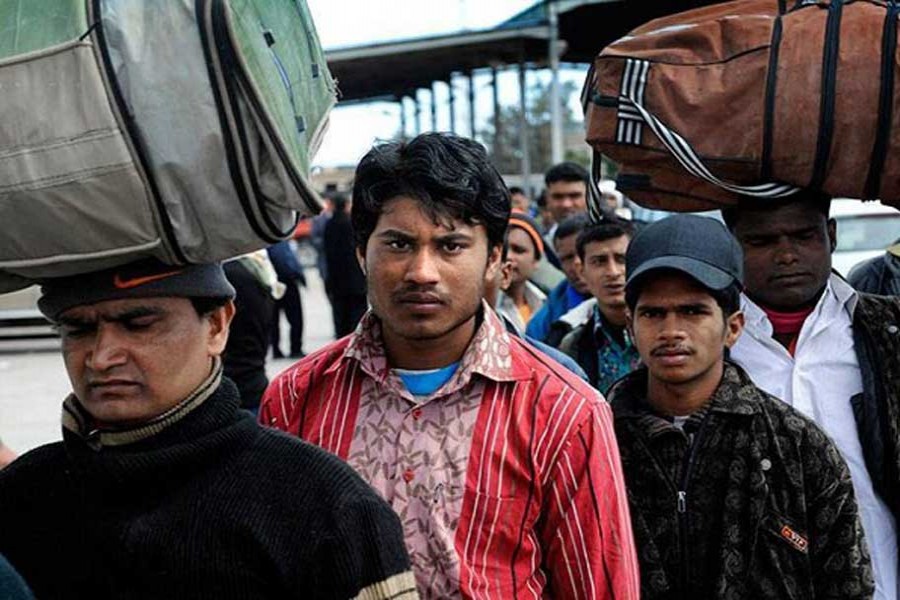The most recent data collected through a survey in 62 villages of the country show that one-third of rural households have at least one migrant member (20 per cent local and 20 per cent foreign). That means two-thirds of rural households have no family member migrating to locations within the country or beyond. If we compare the present level of migration with 25 per cent in 2008 and 20 per cent in 2000, we would notice a rise in the incidence of migration over time. This is not surprising given the improvement in institutional arrangements in the process of migration, stronger pull factor working both inside and outside, and availability of funds being easier now than before. By and large, 70 per cent of the migration takes place within the country --16 per cent within the district and 55 per cent outside the district.
More importantly, internal or external, 90 per cent of the migrants in 2014 hailed from households with poor land asset base (owning 50-100 decimals). Not only that, if we compare the situation with 2000, the incidence of migration among the very poor (owning up to 0.2ha) has increased from 26 per cent to 47 per cent (foreign) and 40 to 58 per cent (domestic). On the other hand, migration by the land-owning class has fallen in the comparable period in both periods. The abovementioned information from household survey leads us to conclude that over time migration has increased as has increased the participation of poor households.
Not long ago, in the discourse on migration, 'psychic cost' captured considerable attention. Critics argued that although migration brings home money, it costs some 'honey' in terms of say, separation from family. But revolution in the arena of communication technology seemingly changed the world, both inside and outside. According to the survey, one-fourth of foreign migrants communicate with their family members every day, while two-thirds communicate at least once a week. The frequency is almost same for landless and land owning members. For example, about 68 per cent of respondents from poor households (owning up to 0.2ha) reported overseas phone calls every week, and 27 per cent daily. About communication within the country, no discussion is perhaps needed since about 85 per cent rural households have mobile phones not only to transact words but also to make financial transactions.
Despite the 'boon' due to communication technology, the bane also exists with migration where a vast majority of foreign migrants feels that staying abroad has cost their children in terms of love, affection and guidance; one-tenth reported social stigma on account of 'unethical or immoral' behaviour of spouse. However, one-fifth of the migrants reported no problem whatsoever.
The survey in 2014 included some returnees who migrated once but now reside at home. It is interesting to look into the causes of their return. About half of them returned on expiry of their contract, about 16 per cent due to 'inferior jobs' and 'lower salary' - a kind of cheating by recruiting agencies which sent them. However, family problems (e.g. dispute over ownership of household assets) and Children's future, separation, 'unethical' behaviour of spouse etc., account for return of roughly 40 per cent of the migrants. Occupational distribution of the returnees shows that one-fourth of them are engaged in farming, about 15 to 22 per cent are unemployed, and the rest engaged in low-paid works.
The returnees also gave their views about the relative position of economic condition at home and abroad. Three-fourths of the returnees reported that their economic condition has deteriorated after return, while 23 per cent experienced some improvement. At disaggregated level, however, majority of the returnees observed a decline in their economic condition, while the land-owning groups observed that their condition has improved. This leads to another question: do they desire to go abroad again? About three-fourths of the migrants from poor households answered in the affirmative while two-thirds of the land-owning group of the migrants (owning 1ha+) responded in the negative.
The survey has made some revelation about female migrants. First, of the total migrants, one-fifth is female. Of this, 65 per cent moved to another district, 26 per cent remained within the district and 8 per cent moved abroad. However, unlike the males, all of them did not migrate for economic reasons, but to accompany their families (about 60 per cent), 16 per cent for education, and the rest to work for income. That means 28 per cent of female migrants are working inside or outside (1 per cent in overseas lands). We do not have comparable data set but a recent estimate shows that overseas female migration has been on the rise: some 56,400 female workers went to foreign countries with jobs in 2013, up from 37,304 in 2012, reflecting a 51 per cent growth, according to the Manpower Bureau data. Among the internal female migrants, about 70 per cent are engaged in jobs, 9.0 per cent work as wage labour. Within district, a female migrant sends roughly Tk.13,000 per year as compared to Tk.44,000 by males. However, across districts, the sum is respectively Tk.25,000 and 50,000. Available information from secondary sources shows that females generally send more remittances than male migrants. Their hard earned money is neither duly recognised nor properly used in the country.
Abdul Bayes is a former Professor of Economics at Jahangirnagar University.


